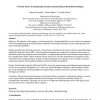Free Online Productivity Tools
i2Speak
i2Symbol
i2OCR
iTex2Img
iWeb2Print
iWeb2Shot
i2Type
iPdf2Split
iPdf2Merge
i2Bopomofo
i2Arabic
i2Style
i2Image
i2PDF
iLatex2Rtf
Sci2ools
ARTMED
2006
2006
A formal theory for spatial representation and reasoning in biomedical ontologies
Objective: The objective of this paper is to demonstrate how a formal spatial theory can be used as an important tool for disambiguating the spatial information embodied in biomedical ontologies and for enhancing their automatic reasoning capabilities. Method and Materials: This paper presents a formal theory of parthood and location relations among individuals, called Basic Inclusion Theory (BIT). Since biomedical ontologies are comprised of assertions about classes of individuals (rather than assertions about individuals), we define parthood and location relations among classes in the extended theory BIT+Cl (Basic Inclusion Theory for Classes). We then demonstrate the usefulness of this formal theory for making the logical structure of spatial information more precise in two ontologies concerned with human anatomy: the Foundational Model of Anatomy (FMA) and GALEN. Results: We find that in both the FMA and GALEN, class-level spatial relations with different logical properties are no...
| Added | 10 Dec 2010 |
| Updated | 10 Dec 2010 |
| Type | Journal |
| Year | 2006 |
| Where | ARTMED |
| Authors | Maureen Donnelly, Thomas Bittner, Cornelius Rosse |
Comments (0)

